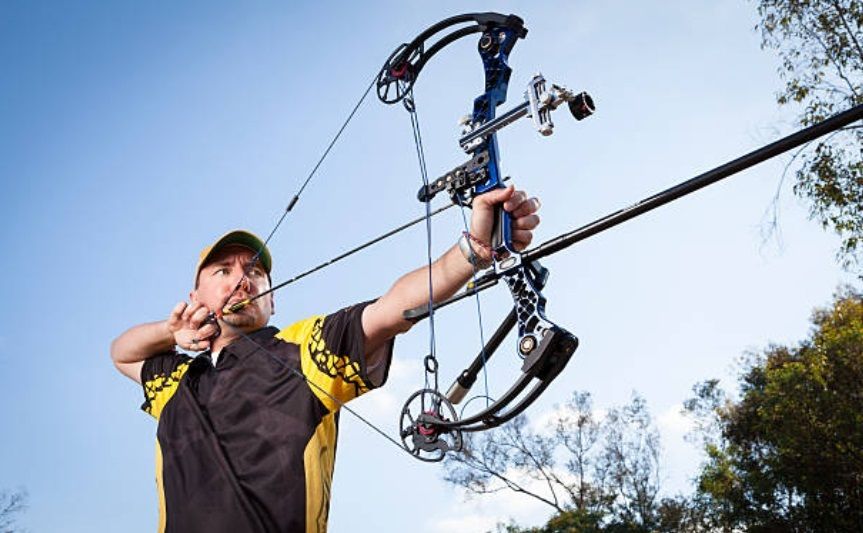A compound bow is a great tool for entertainment. If your kid is not going outside to play, just hand over him a compound bow. You will see the magic.
The compound bow is friendly with the professionals. That’s why it costs a little bit higher than the general bows.
Don’t worry: I have enclosed the necessary instructions on how to make a compound bow. Read the article top to bottom and make it yourself.
Contents
What Do You Need to Make a Compound Bow?
As a compound bow is stronger and efficient than that of a normal bow, it needs so many materials.
I have enclosed almost all the materials. Now you have to gather them all regarding your bow size, your demand, and availability of the materials.
Arrange the pips:
18 inches of ½ inches SCH 40 PVC pipes (Depends on your bow size)
32 inches of 1 inche SCH 40 PVC pipes (Depends on your bow size)
5 feet of 1-1/4 inches SCH 40 PVC pipes (Depends on your bow size)
Containers:
Arrange at least two PVC cement containers. You need only one but the other is extra in case of any inconvenience.
Threads and nuts:
12 1/4-20 nuts
Some 2 4.5 inches pieces of 1/4-20 threaded of rod
Thread locker
Spacers and cords:
4 pieces of ¼ inches nylon spacers
Venetian blind cord 1 roll 9/16 inches
Other materials:
A Spray paint
A Scrap of wood
A hot glue gun
3 feet of 1/4 inches + steel rod
12 Step to Make a Compound Bow
Step 1: Mark the pipes: Take a 5-foot piece of 1-1/4 inches SCH 40 PVC. Mark 16 inches in from each end. Moreover, mark 4 inches on either side of the 16 inches mark. Also, mark the center at 30 inches.
The 16-inch marks are going to be the transition point between limb and riser. The 4 inches marks are going to show where to heat the pipe. We will heat and bend the pipe now.
Step 2: heat the pipes: Take a propane heater. You can use several things. However, this works well. After a few minutes, the pipe will be soft and pliable in the area that is was heated. Try not to burn it.
Step 3: Curve the pipe: lay the pipe in a flat on the floor and press on the side of the pipe. This helps to keep it from kinking where it is bent. Go for a 90-degree angle evenly spread thought the corner curve.
Keep flipping it while pressing the sides, as it cools it will start to hold its shape more and more. Bend it as it cool enough to be not completely floppy but before it hardens. Slowly add bend. Keep pressing the sides to prevent/get rid of kinks.
Don’t make the pipe flat, just slightly oval through the corner for stiffness here. Do that on both ends of the pipe. You might have to reheat parts of each corner to get it symmetrical. Don’t expect it to be perfect doing it by hand like this, but you can get close. Your corner should be 90 degrees but if you can do nearly 90 degrees, it is fine.
Step 4: Heat the riser: Now heat the riser, the section between the corners. Bend this to give it a reasonable brace height. (Distance from handle to string). Put the brace height at 7.5 inches when strung up, this increased to about 9.5 inches so when you are at this stage, set your brace height to about 2 inches to 2.5 inches lower than what you want.
Step 5: Heat and Flatten the limbs: Now it is time to heat and flatten the limbs. The limbs are the sections outside the corners. Press it with the rag, keeping it straight concerning the rest of the bow. Check that it is not twisted. If it is, try to twist it straight before it completely hardens.
Step 6: Fix the dimension: Mark a rectangle on the end of each limb that will be cut open for the cam to go in. Dimensions for this rectangle are 3-3/4 inches by 7/8 inches. Be sure it is centered side-to-side on the limb. Drill a ¼ hole on each edge of both limbs 1/2 inches from the end of the limb.
Take a 1-inch SCH 40 PVC. Mark and cut eight 4 inches sections. Make a lengthwise cut down each 4 inches pipe section. We are going to heat the 4 inches pipe pieces until they are soft, and then press them flat.
Step 7: Mark and cut the plastic plates: Mark circles onto the plastic plates. Four of the plates should take the largest circle that will fit. The four others should take a roughly 1.2 inches smaller diameter circle. These four will make up the idler wheel. Mark the center on one of the large circles for this. ¼ inches difference all the way around. Cut out all the circles.
Step 8: Glue the plates: Glue the layers together. Glue the middle ones, let it sit for a while, then do the outer ones one at a time. Smooth the edges of the center part before gluing on the outer large circles. Drill holes close together along the line.
Drug the bit sideways through the slot to clean it out. Cut areas of the outer circles off to give the strings a slot. Twelve 1/4 -20 nuts, there are lock nuts but you can use regular nuts. The final assembly would be nearly impossible with locknuts. Add twelve washers and four nylon spacers.
Step 9: Make the threaded rod: Cut two 4.5” sections of 1/4-20 threaded rod. Put together the cam assembly outside the bow so you can see it. However, it needs to be in the bow as you put it together to get everything in.
Use the thread locker glue after you have this the way you want it. While the thread locker dries, you can make the string. Take the end of a long string and fold it over like this. Leave 1 inch for the loop, and twist the string around itself for 5 inches. Then coat it with hot glue.
This holds very strongly. Now we will measure how long it should be and make the other end of the string.
Step 10: Make the strings: Now to get the precise length we want and put on the other loops. Measure down 12 inches of string from the loop and glue these two strings together. Follow the same instruction on the other string.
Now you have to make a tool called a “bow vice”. This is a much-improvised way to do it, I’m not even sure what normal ones look like. This works well enough, we need this to string the compound bow.
Step 11: Put the strings the holes: String goes through the hole. Each end the string will be attached to a 4 inches long ¼ inches steel rod. This will go on both ends. When you twist that “L” shaped tube it will pull the bow limbs together. After, all that is left to do is make string adjustments, test fire, and finish with paint and accessories.
Step 12: Adjust: Hook the longer string onto the cam. Press it over the idler wheel. Hook these loops on to the nylon spacers. Now hook the shorter string onto the cam. Turn it directly to the nylon spacers on the opposite axel.
Now release the vice. To shorten draw length, tie knots in the longer string. To increase draw length, tie knots in the shorter one. To increase draw weight, tie knots in both.
Fire once to test it for the first time.
You’re ready to go. Enjoy your handmade compound bow.

